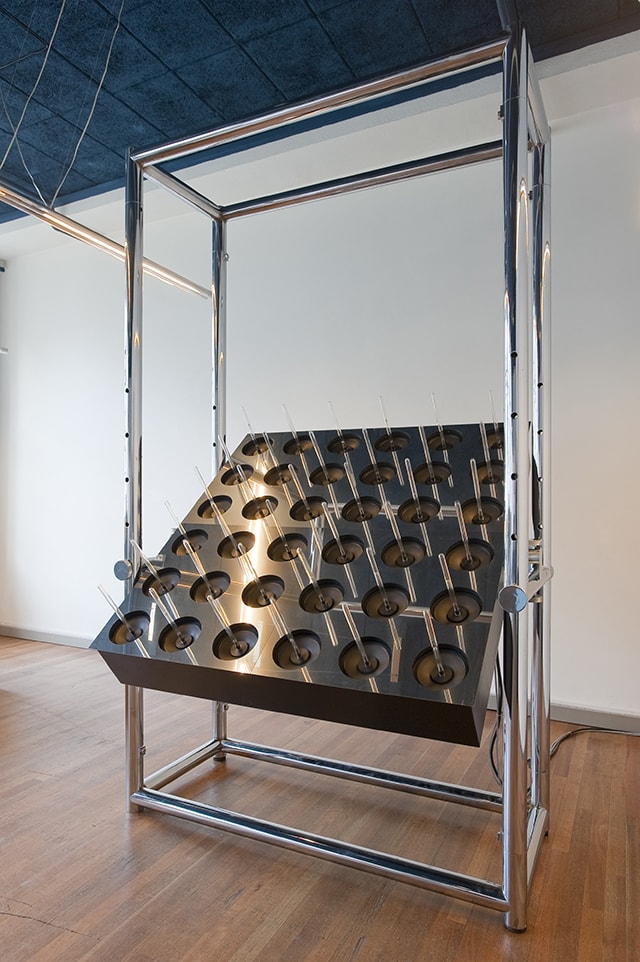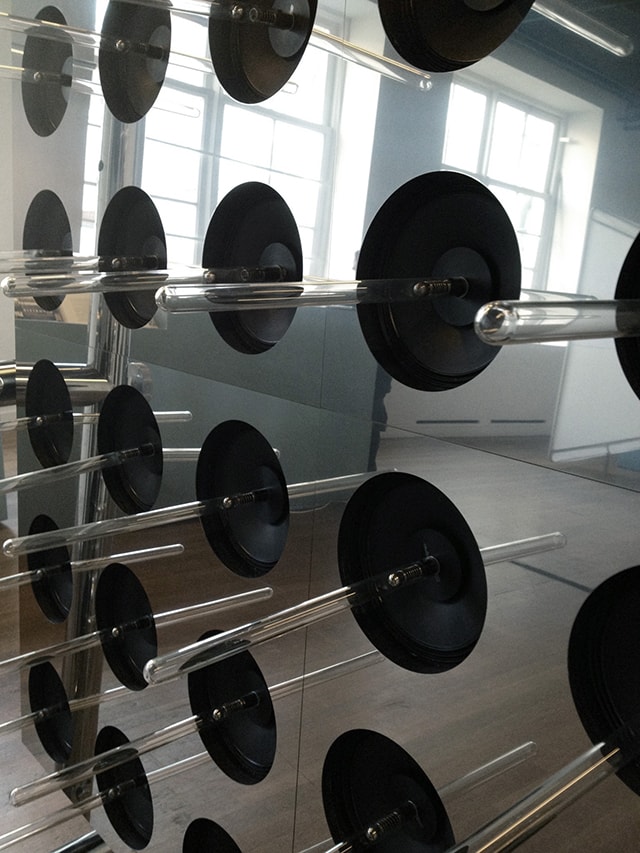title
Ideofoon I
artist
Dick Raaijmakers
intro
In 1967 Dick Raaijmakers launched the principle of the Ideofoon. The name is a contraction of the Dutch words for ‘idea’ and ‘phone’. The central principle, which Raaijmakers developed between 1968 and 1970, is of a loudspeaker which acts as an active ‘speaker’ that composes its own music.
In the Ideofoon series, the loudspeaker is converted from serving as a passive information interpreter and becomes an active speaker. This is achieved by short-circuiting the loudspeaker by connecting the output to the input—causing the loudspeaker to use its own signal and no longer requiring external input, thereby producing autonomous sound.
Ideofoon I is the first in a series of three installations. The installation consisted of thirty-six loudspeakers, with each loudspeaker having a glass tube containing a steel ball attached to it. The loudspeakers were mounted as a grid in chrome housing that slowly rotated back and forth.
biography artist
Dick Raaijmakers (Maastricht, 1930-2013) was a composer, music theater maker, theoretician, and visual artist. He studied piano at conservatories in Tilburg and The Hague. From 1954 to 1960 he worked at Philips in Eindhoven in the electro-acoustic field and in 1957, under the pseudonym Kid Baltan, created the first electronic pop song of all time: Song of the Second Moon.
Considered a great innovator, Raaijmakers worked across multiple disciplines and created connections between visual arts, film, literature, theatre, and the world of music. He also expressed his ideas in numerous lectures, articles and books. Until he retired in 1995, he was a (guest) lecturer at the Royal Conservatory in The Hague, at its departments of composition, the Institute of Sonology, and the ArtScience Interfaculty.
keywords
images
[caption id="attachment_445" align="alignnone" width="640"] Dick Raaijmakers, Ideofoon I, 1970. Nederlands Instituut voor Mediakunst, 2011. Photo: Cassander Eeftinck.[/caption]
[caption id="attachment_444" align="alignnone" width="640"]
Dick Raaijmakers, Ideofoon I, 1970. Nederlands Instituut voor Mediakunst, 2011. Photo: Cassander Eeftinck.[/caption]
[caption id="attachment_444" align="alignnone" width="640"] Dick Raaijmakers, Ideofoon I, 1970. Nederlands Instituut voor Mediakunst, 2011. Photo: Cassander Eeftinck.[/caption]
Dick Raaijmakers, Ideofoon I, 1970. Nederlands Instituut voor Mediakunst, 2011. Photo: Cassander Eeftinck.[/caption]
 Dick Raaijmakers, Ideofoon I, 1970. Nederlands Instituut voor Mediakunst, 2011. Photo: Cassander Eeftinck.[/caption]
[caption id="attachment_444" align="alignnone" width="640"]
Dick Raaijmakers, Ideofoon I, 1970. Nederlands Instituut voor Mediakunst, 2011. Photo: Cassander Eeftinck.[/caption]
[caption id="attachment_444" align="alignnone" width="640"] Dick Raaijmakers, Ideofoon I, 1970. Nederlands Instituut voor Mediakunst, 2011. Photo: Cassander Eeftinck.[/caption]
Dick Raaijmakers, Ideofoon I, 1970. Nederlands Instituut voor Mediakunst, 2011. Photo: Cassander Eeftinck.[/caption]
year
1970-2013
website
premiere
software
functionality
The principle behind the functionality of Ideofoon I is the conversion of the loudspeaker from a passive information provider to an active speaker. This is achieved by short-circuiting the loudspeaker by connecting the output to the input, allowing the loudspeaker to use its own signal and no longer require external information.
The thirty-six loudspeakers were mounted in a chrome housing that rotated back and forth at an angle of ninety degrees around its axis. As the slope changed, the speed with which the balls in the glass tubes rolled back and forth also changed. The audience is able to move around the work and experience it both visually and sonically.
part of collection
A prototype of Ideofoon III is part of the ‘Stedelijk Museum Amsterdam collection’, in the category ‘sculpture’1
production
In 2011, Ideofoon I was reconstructed on the occasion of Dick Raaijmakers winning the Witteveen+Bos prijs voor Kunst+Techniek (prize for art and technology). The reconstructed work was to be presented at the Bergkerk in Deventer in the Netherlands. The reconstruction was commissioned with the Netherlands Media Art Institute (NIMk) and TodaysArt Festival as additional partners. The reconstruction was carried out by René Bakker and, notably, was carried out so well that a technical problem from the original work also appeared in the reconstruction: the movement of the steel balls, as they are pushed through the loudspeakers in the glass tubes, create destructive sparks. In order to guarantee the successful operation of the work (for later presentations at the Gemeentemuseum Den Haag and the Johan Wagenaar Foundation), Bram Vreven optimised the alignment of the working parts and their operation to minimise the sparks and damage to the glass tubes. The reconstruction costs were also supported by the Société Gavigniès.
hardware
Thirty-six loudspeakers. Each loudspeaker has a glass tube attached at its centre, containing a steel ball.
technical specs
intention artistquote by artist
quote
In a letter from 1954, to his friend Miep Oddens, he questioned the role of the loudspeaker:
"Starting from the idea that in principle the sound from a loudspeaker sounds different at every place and not the same as they say, I think it is good that the sound of the loudspeaker itself is seen as the source, causer, of a whole series of new, more or less related sounds. ( . . . ) It is very spectacular that an aircraft does that: flying far away causes the sounds to change and to change with a non-changing sound source, for example the jet turbines. ( . . . ) It is important to compose in such a way that the final sound - caused by the sound of a single speaker - is so changeable after it has left the loudspeaker, that it has become a new series of sounds that caused the one copy. ( . . . ) In this context I make a strict distinction between the sound processing towards the loudspeaker (that is the way one always did and does) and the composing of changes that the sounds once released from the loudspeaker: the speaker-off sounds.”2
influence
The ArtScience Interfaculty, founded in 1989 by Frans Evers and Dick Raaijmakers, was an innovative faculty that trained artists to work in the field of media, in the experimental and creative use of technologies, and in the synaesthetic union between sound and image. As an extension of this faculty, an entire generation of artists and curators have been influenced by the work and ideas of Raaijmakers.
As stated in the introduction to Raaijmakers’ Monograph on the V2_ website, “‘[t]he works and installations, music and theater performances of Dick Raaijmakers are of such originality that they do not know their equal worldwide. His influence on colleagues from his own generation, but especially on younger generations of artists, can also be called enormous.”3
Raaijmakers himself was influenced by his work in the acoustic department at the NatLab at Philips, where he took care of the maintenance of the electronic reverberation equipment. His experience with this equipment influenced his thinking about the spatial representation of composed sound.
context
LITERATURE
Festival Dag in De Branding, dagindebranding.nl.
Bosma, Hannah. “Canonisation and Documentation of Interdisciplinary Electroacoustic Music, Exemplified by Three Cases from the Netherlands: Dick Raaijmakers, Michel Waisvisz and Huba De Graaff.” Organised Sound, vol. 22, no. 02, Aug. 2017, pp. 228–237.
Mulder, Arjen, and Joke Brouwer. Dick Raaymakers: a Monograph. V2-Institute for the Unstable Media, 2008.
Mulder, Arjen, and Maaike Post. “interview Raaijmakers.” Book for the Electronic Arts. De Balie, 2000. 8-24.
Raaijmakers, Dick. “Dick Raaijmakers.” Geluid Kijken: Drie Audio-Visuele Projekten / Sound Sight: Three Audio-Visual Projects. Translated by Ina Rike, Stedelijk Museum, 1971.
Tazelaar, Kees. “De Luidspreker Spreekt. Korte introductie op de Ideofonen door Kees Tazelaar.” Johan Wagenaar Stichting, johanwagenaarstichting.nl (pdf).
van Peer, René. “Spookgeluiden En ‘Carnaval Achterstevoren’ in Tentoonstelling Rond Muziekpionier Dick Raaijmakers.”, ed.nl.
part of active discussion
scene artists institutes
V2_, STEIM, Philips Physics Laboratory (NatLab), Royal Conservatory in The Hague
footnote
1 “Prototype Ideofoon III - Dick Raaijmakers.” Stedelijk Museum Amsterdam, stedelijk.nl.
2 Kees Tazelaar, “De Luidspreker Spreekt.” Johan Wagenaar Stichting, johanwagenaarstichting.nl (pdf). 3 “Dick Raaijmakers Monografie.” V2_Institute For the Unstable Media, 9 Aug. 2018, v2.nl.
Annie Abrahams
Livinus van de Bundt & Jeep van de Bundt
Driessens & Verstappen (Erwin Driessens and Maria Verstappen)
Yvonne le Grand
Edward Ihnatowicz
JODI (Joan Heemskerk & Dirk Paesmans)
Bas van Koolwijk
Lancel/Maat (Karen Lancel and Hermen Maat)
Jan Robert Leegte
Peter Luining
Martine Neddam
Marnix de Nijs and Edwin van der Heide
Dick Raaijmakers
Joost Rekveld
Remko Scha
Jeffrey Shaw
Debra Solomon
Steina
Peter Struycken
Michel Waisvisz